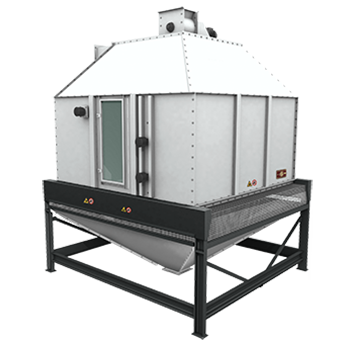Reasons for pellet cooling
In the pelleting process, cooling is essential for several reasons, cooling is required to prevent mold and stabilize the residual moisture.
- Preservation of Pellet Quality: Cooling helps maintain the structural integrity of pellets by reducing their temperature rapidly after the pelleting process. This prevents pellets from sticking together or deforming, ensuring uniformity in size and shape.
- Moisture Control: Cooling removes excess moisture from the freshly produced pellets. Proper moisture content is crucial for the quality and shelf-life of pellets. Cooling helps achieve the desired moisture level, preventing issues like mold growth or degradation.
- Reduced Risk of Combustion: Pellets, especially those made from organic materials like biomass, can generate heat during the pelleting process due to friction and compression. Cooling helps dissipate this heat, reducing the risk of spontaneous combustion during storage or transportation.
- Improved Handling and Packaging: Cooled pellets are easier to handle and package compared to hot pellets. They are less likely to deform or break during handling and are safer to transport and store without the risk of heat-related issues.
- Energy Efficiency: Cooling the pellets allows for the recovery of heat energy, which can be reused in the pelleting process or for other purposes within the manufacturing facility, improving overall energy efficiency.
- Quality Assurance: Proper cooling ensures that pellets meet quality standards and specifications. It helps eliminate defects and inconsistencies, ensuring that the final product meets customer requirements and regulatory standards.
Overall, cooling is a critical step in the pelleting process to ensure the production of high-quality pellets that are safe, durable, and suitable for their intended applications.
La Meccanica produces 3 types of pellet coolers:
- the counterflow cooler, the most known and used in all sectors and represents the solution with the best cost/performance ratio of pellet cooling
- the horizontal cooler, used only in the animal feed sector when vertical space is limited
- the vertical cooling group, is used also only in the animal feed sector and takes a minimal amount of floor space
The counterflow cooler
A counterflow pellet cooler is a piece of equipment commonly used in the production of pellets, such as animal feed pellets or wood pellets. Its purpose is to reduce the temperature of the pellets after they have been extruded or processed at high temperatures.

The cooler works on the principle of counterflow heat exchange, where the pellets move in one direction while a stream of cool air or water moves in the opposite direction. This setup maximizes the temperature differential between the pellets and the cooling medium, facilitating efficient heat transfer.
Counterflow pellet coolers are preferred in pellet production because they offer several advantages:
- takes up little floor space
- its design maximizes heat transfer efficiency
- requires low volumes of air
- good function even at the beginning and end of production
- rapid cooling helps prevent pellet breakage or deformation
- little maintenance
- limited initial investment.
Discover more about La Meccanica Counterflow Cooler on our product page!